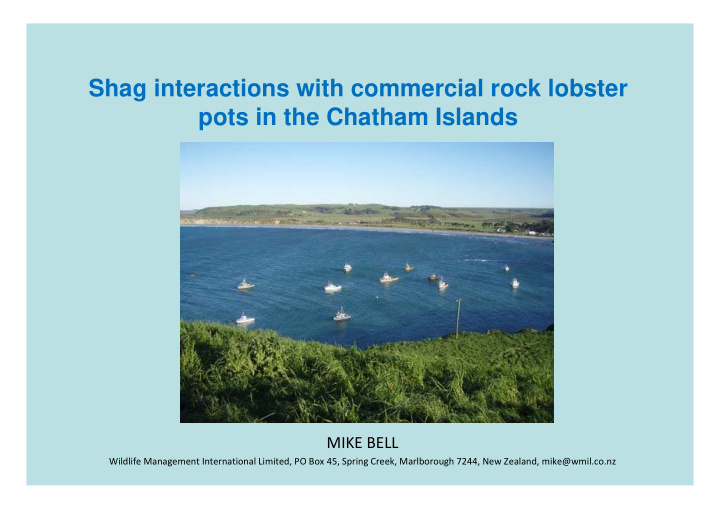



Shag interactions with commercial rock lobster pots in the Chatham Islands MIKE BELL Wildlife Management International Limited, PO Box 45, Spring Creek, Marlborough 7244, New Zealand, mike@wmil.co.nz
Shag interactions with pot fishing Methods • Interview survey, with design input from DOC and CRA6 Industry Association • 22 fisherman interviewed • 10 at CRA6 organised meeting, 9 face to face, 3 follow up phone interviews • Fishing effort data from MAF fisheries assessment report (Starr 2011) • Shag population data from Debski (2012) – previously reported today
Shag interactions with pot fishing Chatham Island shag • Endemic Chatham Island species • 842 pairs counted in 1997/98. • 355 pairs in 2011 • = 58% decline
Shag interactions with pot fishing Chatham Island shag • Endemic Chatham Island species • 388 nests in 2011 • 649 nests in 1997/98 • 388 nests in 2011 • = 40% decline
Shag interactions with pot fishing Fishing effort • From the 1979 ‐ 80 fishing season to the 1998 ‐ 1999 season an average of 48 vessels (range 39 ‐ 59) • Declined to 34 vessels since the 1999 ‐ 2000 season • Annual number of pot lifts has remained relatively stable with an average of 285,300 pot lifts per season (range 163,500 – 428,000) • Therefore fewer boats now working in the Chatham Islands, but they are working the same amount of gear.
Shag interactions with pot fishing Shag interactions • 9 fishermen (40%) acknowledged catching shags • All reported bycatch involved Pitt Island shag • Fishermen reported low levels of bycatch during their career, with between 1 – 5 shags caught • All involved shags being found dead in pots when working gear
Shag interactions with pot fishing Shag interactions Bycatch per CRA6 area Tota 940 941 942 943 l Shags 5 3 12 0 20 caught Fishing 26 27 35 12 100 effort % 1997Shag 718 250 48 340 80 numbers
Shag interactions with pot fishing Shag interactions • All caught >5 years ago, most>10 years • Shag bycatch occurred in shallow water when pots brought in close to follow rock lobster January/ February • Hanging bait used • Large necked pots with large mesh used • Fishing methods changed in CRA6, especially pot design and baiting method. • These changes reported to have eliminated bycatch
Shag interactions with pot fishing
Shag interactions with pot fishing Shag interactions rates • Limited international data on seabird interactions with pot fisheries • Chatham Islands ‐ 1 capture/150,000 pot lifts (this study) • South Australia ‐ 1 capture/45,000 pot lifts • Florida ‐ 1 capture/ 4,250 pot lifts • Baja ‐ 1 capture/ 137 pot lifts • No global mitigation methods developed for seabirds • CRA6 has developed a Code of Practise
Shag interactions with pot fishing CRA6 Code of Practise • Don’t set pots alongside nesting sites; don’t set pots in the vicinity of mating birds. • Don’t set pots when shags are sitting on the surface close to the boat. • Don’t use tied baits. • Where possible use frozen baits if setting pots in vicinity of shag colonies. • Watch pots carefully as they are set; be prepared to recover a pot if you see a bird dive after it. • Release the bird after re ‐ setting the pot. • Last resort – use cover panels on pot necks which release after one/two hour soak time. Timed release units or even candy sticks could be deployed to activate the cover panels. (Based on the certainty that only way a shag can enter a pot is to dive through the neck) • Use mandatory non ‐ fish by ‐ catch reporting forms if any fishing ‐ related seabird mortalities are experienced.
Shag interactions with pot fishing Recommendations • Continued use of pots with a narrow neck, small mesh size and only bait with snifters. • Review and update the CRA6 Seabird Interaction Code of Practise. • Produce a “shag fact sheet” for the CRA6 area and distributed to CRA6 fishermen and quota owners. • Initiate an in ‐ depth research project into breeding ecology and foraging behaviour and range of Chatham Island and Pitt Island shags.
Shag interactions with pot fishing ACKNOWLEDGEMENTS: • This work is funded through the Conservation Services Programme (Project INT2011/02), Department of Conservation. Igor Debski was the primary link between Wildlife Management International Ltd and the Department of Conservation • Thanks to Jeff Clarke (CRA6 Industry Association) and Daryl Sykes (New Zealand Rock Lobster Industry Council) for assistance and input into this study • Kelvin Floyd (WMIL) produced the maps
Recommend
More recommend